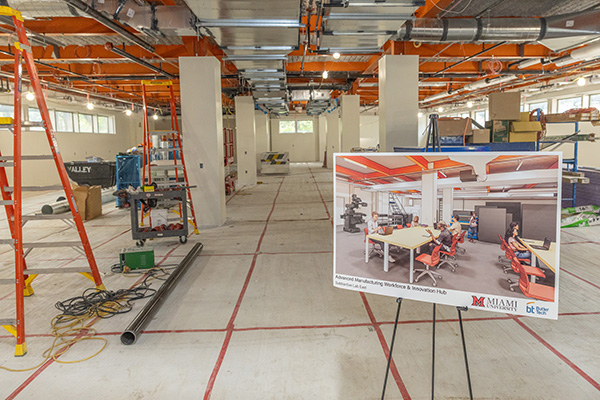Miami University receives $1.5M grant for AI-powered manufacturing safety training project
New SIGHT initiative combines artificial intelligence with augmented reality with the aim to reduce preventable workplace injuries

Miami University receives $1.5M grant for AI-powered manufacturing safety training project
Miami University has been awarded a $1.5 million Workforce Safety Innovation Center (WSIC) grant from the Ohio Bureau of Workers’ Compensation to launch the Safety Immersion and Gamified Hazard Training (SIGHT) for Industry 5.0 Workers.
The Farmer School of Business and the Advanced Manufacturing Workforce and Innovation Hub in Hamilton are collaborating to revolutionize safety training for Ohio’s manufacturing workers. The innovative project combines Artificial Intelligence (AI), Virtual Reality (VR), and Augmented Reality (AR) to reduce preventable workplace injuries across one of Ohio’s largest employment sectors.
The SIGHT initiative aims to transform safety training by creating personalized and continuously accessible gamified modules that adapt to each worker’s skill level and work environment. Starting this month, the two-year program will develop complementary VR and AR platforms designed to change how workers recognize and respond to workplace hazards as well as increase job readiness.
“This is a pivotal moment not just for Miami but for the future of Ohio’s industrial safety and competitiveness,” said Fadel Megahed, professor of Information Systems and Analytics and one of the project’s leaders.
Mohammed Mayyas, chair and professor of Engineering Technology, associate dean for Strategic Initiatives, and a driving force behind the new Advanced Manufacturing Workforce and Innovation Hub, highlighted the Hub’s pivotal role in advancing the SIGHT initiative. The Hub will open in January 2026 as part of the Polytechnic Campus through MiamiTHRIVE.
“The AM Hub will serve as a hands-on, interdisciplinary ecosystem where students, faculty, and industry partners collaborate to apply and refine AI-powered safety technologies in real manufacturing settings,” Mayyas said. “It bridges education, innovation, and workforce development — ensuring our region remains competitive and our workforce is both highly skilled and safety-conscious.”
SIGHT will deliver safety training through two integrated programs. The first is a VR training platform that uses generative AI to create customized hazard simulations based on a worker’s specific work environment. The second is AR coaching that uses sensor data to deliver safety and productivity feedback in real time.
Both programs require minimal technology — the VR system needs only a web browser, with no specialized equipment. The platforms will accommodate diverse users through natural language interfaces, making training accessible to multilingual, hard of hearing, or low vision individuals.
Manufacturing workers across Ohio will eventually use SIGHT for safety training, with expansion to companies outside of Ohio planned by 2028. The program will particularly benefit small and mid-sized companies that lack dedicated safety training staff or advanced technological infrastructure. Technicians from partner sites like Cincinnati Radiator will receive AR-guided safety training on-site, while students from Miami University and Butler Tech Career Technical Center will use the VR modules to simulate realistic hazard scenarios at the Advanced Manufacturing Workforce and Innovation Hub.
“This solution builds not only technical knowledge but also hazard recognition instincts — which are vital in high-stakes environments,” Megahed said.
Industry collaborators such as MaxByte Technologies and MeetKai, Inc. are also playing a critical role — MaxByte is leading the integration of AR and industrial Internet of Things (IoT) technologies for real-time safety coaching, while MeetKai is providing advanced VR development tools to power scalable, AI-driven training modules for statewide deployment.
Traditional safety training within manufacturing is limited, with workers receiving generalized training during onboarding or at set intervals that doesn’t address changing workplace hazards or individual needs. This training model leaves the almost 700,000 of Ohio’s manufacturing workers more susceptible to preventable workplace injuries like cuts, crushing wounds, and lacerations.
SIGHT’s AI and VR programs allow workers to continually test their safety skills with personalized modules accessible at any time, ensuring they receive up-to-date and relevant safety training. The platforms will also help workers upskill and reskill so they can adapt to environmental and equipment changes.
Four Miami University faculty members spearheaded this initiative: Megahed and Mayyas; Arthur Carvalho, Dinesh & Ila Paliwal Innovation Chair and associate professor of Information Systems and Analytics; and Zhe “Jay” Shan, Rose-Marie Garcia Anderson Chair and assistant professor of Information Systems and Analytics.
“This is a prime example of Miami’s commitment to interdisciplinary solutions and industry-connected education,” Mayyas said. “We’re aligning advanced manufacturing capabilities with cutting-edge AI to make our workforce safer, smarter, and more future-ready.”